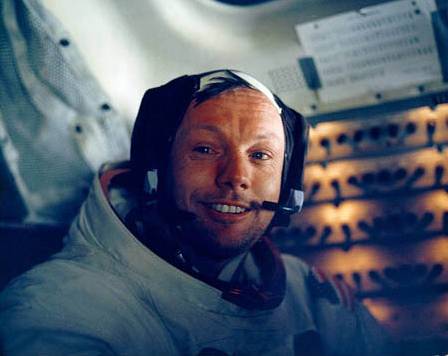 |
| Armstrong's Missing Picture |
| The Cause |
| When the crew of Apollo 11 returned safely to the Earth after their epic journey to the Moon and back, the film magazines they brought with them were transferred to NASA's special photographic receiving laboratory for developing. Soon NASA's PR people were looking at these breath-taking images and looking for the best photographs of Armstrong on the Moon's surface. It soon became clear that this wasn't going to be as easy as first thought and soon they were looking for any photo of the first man on the Moon. When they couldn't find any they thought about using one of Buzz Aldrin and claiming that it was Neil Armstrong. Thankfully in the end they never did this but it did mean that all the images released to the press were of Aldrin. So what happened to result in such an oversight that led NASA's PR team to miss the photo opportunity of all time? |
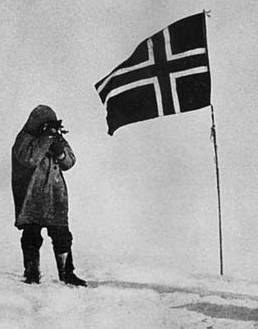 |
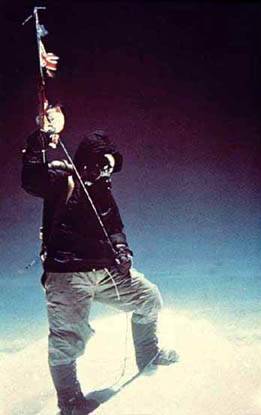 |
| The Precedents |
| When Capt. James Cook explored the south seas in 1770, he took along an artist to record the new lands found there. When Columbus sailed to the New World in 1492 artists used chisels to craft woodcuts of the lands discovered over the horizon. In more modern times when the Antarctic explorer Roald Amundsen and his team reached the South Pole in 1911 (right), they were able capture the moment on film despite the hostile conditions that threatened them, indeed the next team to follow Amundsen died on their return journey. Tenzing Norgay spent less than 20 minutes at the peak of Mount Everest (left) when he conquered the tallest mountain in the world with Sir Edmund Hillary in 1952. Despite the short stay at the top and the dangerous conditions they were able to photograph Norgay holding the British Union Flag against a sky that rapidly changed from light blue to black. |
| The crew of Apollo 11 had over one and a half hours in which Aldrin could have photographed Armstrong and yet no decent photograph of the first man to stand on the Moon during that first exploration of a new world exists. |
| History is full of brave men and women who have risked their lives to go where no other human being has been before and the moment has always been captured in some form. |
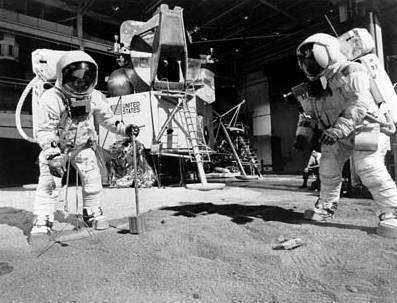 |
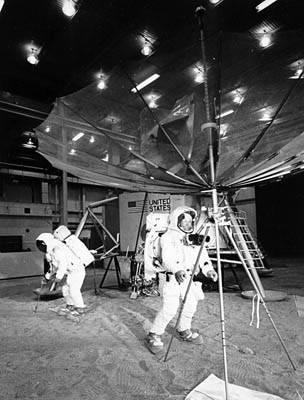 |
 |
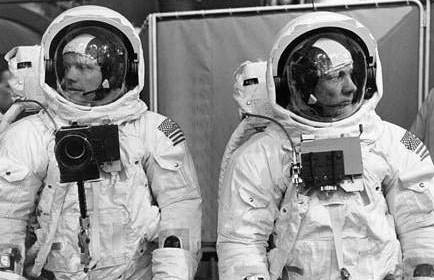 |
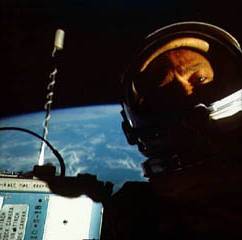 |
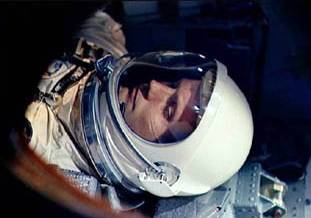 |
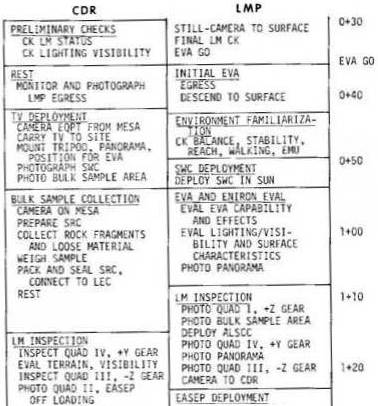 |
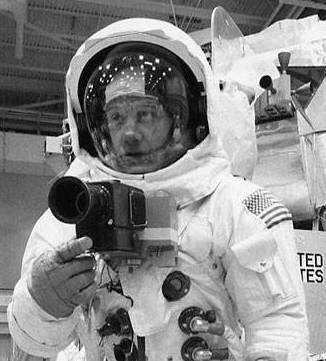 |
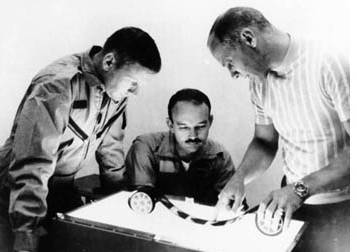 |
 |
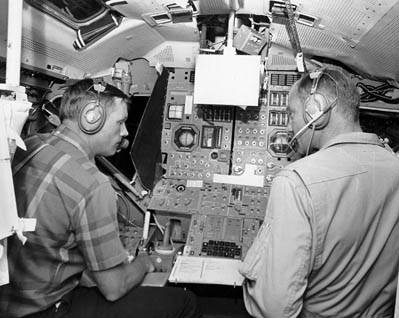 |
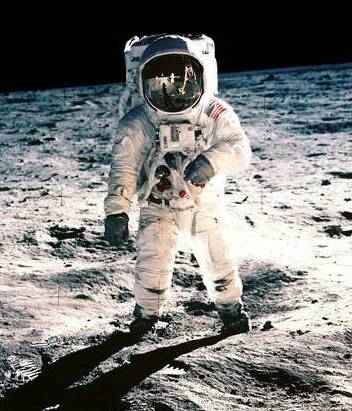 |
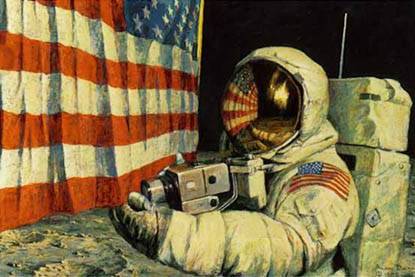 |
| Training |
| On the Earth the crew trained for every activity many times over and yet this training failed to include such an important objective. |
| Yet for all their training when they finally got to the Moon they had never been trained to take tourist type photos of each other for the PR people back home. All the photographs Aldrin took on the surface were pre-planned to include panoramas of the landing site and close-ups of the LM nothing else. |
| As Aldrin later said, |
| "As the sequence of lunar operations evolved, Neil had the camera most of the time and the majority of pictures taken on the Moon that include an astronaut are of me. It wasn't until we were back on Earth and in the lunar receiving laboratory looking over the pictures that we realized there were few pictures of Neil. My fault perhaps but we had never simulated this in our training." |
| According to the Apollo 11 checklist (above) after Armstrong had gathered the bulk sample collection he was to place the camera onto the MESA so that the LMP could use it, as he later said, "We always had a plan for when we were going to transfer the camera. He was going to take some pictures and I was going to take some. Buzz did have the camera some of the time and did take pictures. It was in the flight plan." During Aldrin's time with the camera he was to conduct a photographic inspection of the Lunar Module followed by a panoramic series before passing the camera back to Armstrong. It was during this panoramic series that Aldrin took a photo that included Armstrong at the MESA (right). |
| Aldrin trains with the Hasselblad camera. |
| In the short time they had out on the surface each man had a checklist that they followed attached to the wrist of their spacesuit. As they and all future Apollo astronauts discovered, time goes fast on the Moon. In all Buzz Aldrin had little over an hour and a half to get all his tasks done after he had stepped onto the Moon. They had few opportunities to deviate from the flight plan and if it wasn't on the cuff checklist then it just didn't get done. Brian Duff, head of public affairs at the MSC said, "The astronauts were on the surface of the Moon a relatively short time. They had a great deal to do and no one was about to ask them questions or ask them to do anything that was not absolutely necessary. We all believed we getting photographs of both men." Chris Kraft said of the photographic assignments for the moonwalk, " There were all kinds of scientific reasons to take pictures and all kinds of plans to take pictures of the lunar landscape, but I don't think there was ever any game plan to have them take a picture of each other". It should be remembered that between them both Neil and Buzz only took one photo of Michael Collins during the entire mission. Although not as important as securing an image of the first man on the moon standing on the surface, it does go to show that superfluous pictures of crew members were not high on the photographic agenda. |
| The President |
| According to Aldrin in his biography, "Men From Earth", just after Armstrong had taken his photo next to the U.S. flag, he was going to swap places with him and take a shot of Armstrong next to the flag. Aldrin states that at this moment they were interrupted by President Nixon's telephone call and that after the call was finished the two astronauts started working again and the moment was gone. According to the timeline though, there was about five minutes between the time Armstrong took Aldrin's photograph next to the U.S. flag and the moment that Capcom Bruce McCandless asked the two of them to get into the field of view in front of the TV camera so that the President could talk to them. This would seem to lead to the conclusion that the President's call did not have any effect on Armstrong not getting his photograph taken. |
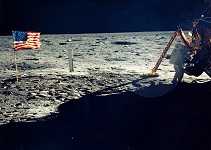 |
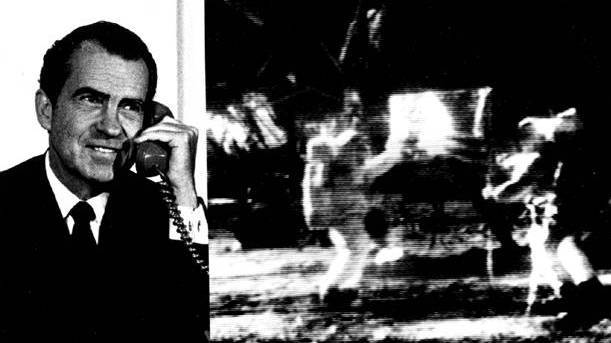 |
| The Grudge |
| There are those that believe that the real reason Armstrong never had any good photos taken of himself on the moon's surface is because of a grudge on Aldrin's part at being denied the first step onto the Moon. Of course anyone that considers this to be the truth doesn't really understand the kind of men flying the Apollo missions. |
| Armstrong and Aldrin during training. |
| Apollo 7 astronaut Walt Cunningham said, "We had always assumed Neil Armstrong, who was the spacecraft commander, was going to be the first man on the Moon. We always felt like it was an unnecessary conflict that was created by Buzz and kinda left a bad taste in other peoples mouth about Buzz making this fuss about it." To be fair to Aldrin, it wasn't always assumed that Armstrong would be first out, indeed during the early simulations the LMP was out first. As the matter of who would be first out went unresolved Buzz said that, "At one time I made the observation to Neil that I felt we needed a decision on this and that one way or the other, regardless of how I felt or he felt, we needed to have a decision made on this. His observation was something to the effect that he realised the historical significance and that he was not going to make a decision that would rule him out of that opportunity." Although Armstrong has never admitting to pulling rank as commander, he did make it clear that he wanted to be in the position of being first onto the Moon's surface. In the end it was up to Deke Slayton, their boss in the astronaut office, to take the crew aside and state simply that Armstrong would be first out followed by Aldrin and that was an end to the matter as far as Slayton was concerned. In his book 'Deke' he wrote on this matter, "It bounced back to me and I told Buzz I thought it should be Neil on seniority. I felt pretty strongly that the ones who had been with the program the longest deserved first crack at the goodies. Neil had come into the program in 1962, a year ahead of Buzz, so he had first choice. I can't say I saw too many outbursts between Neil and Buzz. Given the incredible stress they were under, they held up pretty well." So Slayton let the crew know who was going to be the first man on the Moon and Aldrin said of this, "Within a week or two there was a decision made that Neil would be the first one and being a military man and understanding seniority that was perfectly alright with me." Over the years many have taken this incident and turned it into a major part of the Apollo 11 story even making Aldrin out to be the bad guy by selfishly refusing to take Armstrong's photo on the Moon, as in the newspaper story below. |
| Neil Armstrong seen inside the Gemini VIII spacecraft waiting for launch. As commander he would have stayed inside while Dave Scott, his co-pilot, would have conducted an EVA. Due to the emergency that led to the mission being aborted after only 10 hours, Scott never got the opportunity to open his hatch. |
| In a rare photo the face behind the gold visor is revealed as Aldrin briefly raises his EVA visor during his time outside on Gemini XII. |
| According to Aldrin when he was told that he was to going to be the second man on the Moon he accepted this fact and got on with the mission training and planning. His take on the whole issue was, "I think all the attention focused in on that and regrettably promoted a disharmony among our crew. There was a bit more of a pressure being the prime crew and that pressure was irritated, it was exasperated by the issue of who would be the first and second and we were the innocent pawns, I think, in that whole issue." In the end I think that it comes down to the following reasons why no good photograph exists of Neil Armstrong on the Moon's surface. Lack of foresight in training and by the NASA photographic unit. The interruption by the President as the astronauts were by the flag taking photos. The fact that only one Hasselblad camera was taken onto the surface. The short amount of time on the moon and the intense work load both men had in that brief period. The final word on this matter should go to Aldrin who stated, "When I got back and someone said, "There's not any of Neil," I felt so bad about that". |
| Richard Underwood, the NASA supervisor for space photography, stated in the above newspaper article, "There's a simple explanation, Aldrin was really mad at Armstrong for seizing the honour of being the first to walk on the Moon. Aldrin decided to get even with him, there was no way he was going to take Armstrong's picture." Aldrin's explanation is more credible, "I think that given the situation and the spontaneity of so much that was happening we came back with some pretty fantastic pictures, thanks in large to the great skill of Neil as a photographer." It would seem that for someone in charge of the photographic objectives of the mission, Underwood would find Aldrin a very useful scapegoat to cover over the huge PR blunder of missing this photo opportunity. Anyone that believes the grudge theory should ask themselves this, when did it become Aldrin's fault that Armstrong never asked for his photo to be taken? On Apollo 12 Pete Conrad did just this when standing next to the U.S. flag he asked, "Can we have a quickie (tourist photo) here"? Bean replied, "Okay". Conrad then went onto give his LMP directions, "Back up a little more to about 15 feet". After that he confirms with Bean, "Get it"? To which his LMP answers, "Sure did". Conrad being Conrad then asks, "Another one"? |
| There was one other factor in the matter of who went out first as Slayton mentions in his book 'Deke.' "There was a technical reason. It turns out that the lunar module was configured differently than the Gemini, in which you had two equally usable hatches. There was just the one hatch on the front of the lunar module and the way it opened made it easier for the guy on the left, the commander, to get out first. Otherwise you'd have two guys in bulky pressure suits doing some kind of goddam dance inside the lunar module." Is this the whole truth? Well if NASA was able to put two men onto the moon surely they could figure out a way to get the LMP out first, possibly by having the two crew men swop places before they donned their PLSS's. It would appear that Slayton didn't want to be known as the man that denied Aldrin the honour of being first out so the technical explanation of the lunar module hatch saved him that worry. |
| Seen inside the LM simulator the cramped conditions meant that it was actually easier for the commander to exit the hatch first. |
| So while Armstrong's name is recorded in the history books, it is usually Aldrin's image that is shown, as in this famous pose at Tranquillity Base (left). If a photograph did exist of Armstrong on the Moon, then this would probably have been one of the most amazing images of the 20th century and used more widely than any other space related photo. Perhaps it is a little fitting that just like the explorers of old, all we have is this painting, (above) by fellow astronaut Alan Bean, of Armstrong unfurling the Stars and Stripes on the lunar surface. |
| Back To Index |
| Alan Bean's online Art Gallery |
| Neil Armstrong, photographed by Buzz Aldrin, inside the lunar module Eagle shortly after becoming the first man to step onto the Moon's surface. |
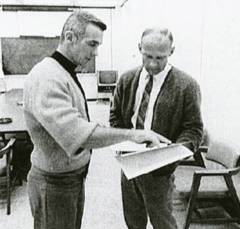 |
| When Aldrin started making enquiries about who would go out first, according to him, it was simply to clear the matter up. Within the astronaut office this caused some friction with his fellow astronauts, Eugene Cernan being one such astronaut who in his book, 'The Last Man On The Moon' wrote the following on the whole matter. "Buzz Aldrin had worked himself into a frenzy with his campaign to be the first man to walk on the Moon. He came flapping into my office at the Manned Spacecraft Center one day like an angry stork, laden with charts and graphs and statistics, arguing what he considered to be obvious-that he, the lunar module pilot, and not Neil Armstrong, the mission commander, should be the first one down the ladder on Apollo 11. Since I shared an office with Neil, who was away training that day, I found Aldrin's arguments both offensive and ridiculous. Ever since learning that Apollo 11 would attempt the first Moon landing, Buzz had pursued this peculiar effort to sneak his way into history, and was met at every turn by angry stares and muttered insults from his fellow astronauts." There is probably little love lost between Cernan and Aldrin. In his book, Cernan belittles Aldrin's EVA achievments during Gemini XII and as Aldrin points out it should be remembered that every Navy guy in the program would have been, "charging hard for everything they could possibly get". Therefore to criticise Aldrin for pushing for something he wanted is a little hypocritical. Indeed, Cernan was so intent on getting his own command that he turned down the LMP role on Apollo 16. |
| Cernan and Aldrin discuss the Apollo 11 mission. |
| In a 2005 book by Andrew Smith called, "Moon Dust" the author states that, "At one point, Armstrong actually called his junior over to snap him by a commemorative plaque he'd just unveiled but the LM pilot, hilariously, barked back that he was too busy". The only comments that these could relate to are ones made immediately following the plaque ceremony, (from the Apollo Lunar Surface Journal) 109:53:40 Armstrong: (To Buzz) Ready for the camera? No, I'll get it. 109:53:43 Aldrin: No, you take this TV on out. Is this Armstrong asking Buzz to take the camera off him so that he could have his photo taken beside the unveiled plague. It certainly would be a great photo opportunity resulting in a memorable photo, and was this Aldrin refusing to take Armstrongs photo? Or was it simply Armstrong asking if it was the right moment for Aldrin to take the camera off him according to the mission timeline and Aldrin doing nothing more than correcting his commander and stating that it was in fact time for the TV to be taken out to it's new position away from the Lunar Module. Did Armstrong simply get the sequence of events momentarily mixed up and Andrew Smith is making a leap of imagination trying to make the evidence fit the crime or is this indeed proof that Aldrin wasn't going to take any photos of his fellow moonwalker? On the matter of Armstrong asking for his photo to be taken Cernan said, "Certainly Neil realised the significance of the moment but he was not going to be so arrogant as to say, "Here, Buzz, take a picture of me." Either way it's very vague and certainly not an outright question like Conrad's on the next mission. As for Cernan's comment about Armstrong not being arrogant and asking for his photo to be taken, well Conrad did, twice! |
| The 'Amateur Photographer Magazine' dated 16 July 1969 had a special article on Space and Photography which contained the comment, "Apollo 9 and 10 set the scene for today when Neil Armstrong, Michael Collins and Edwin Aldrin leave Earth to visit the surface of the Moon. A man actually on the Moon will operate a camera. All the Earth is agog to see the pictures he takes". Interestingly it says, "Aldrin joins Armstrong after thirty minutes. Photographs Lunar Module in close-up, especially legs, footpads and soil displaced by braking rockets. Photograph samples of lunar surface before picking up for return to Earth". It doesn't actually say that he will take any photographs of Armstrong but at the end next to a large question mark it adds, "Crew have rehearsed photo tasks. Results forseeable but always there is the unsuspected picture full of drama like the Earth rise from Apollo 8. |
| Did Armstrong ask for his photo to be taken? |
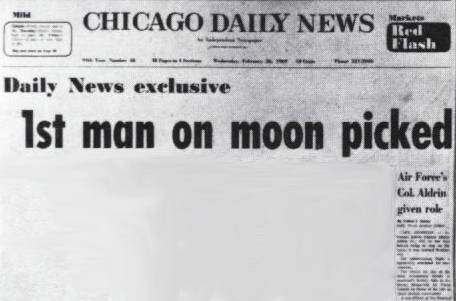 |
| During Project Gemini, the previous U.S space program, it was always the co-pilot that exited the spacecraft and walked in space whilst the commander stayed inside monitoring systems and photographing the EVA. Now in Apollo, Aldrin expected that order to continue with himself taking the first step followed by the commander of the mission a few minutes later. During the first few planning meetings for the moonwalk the matter of who went out first was not raised, it was only after the sequence of who would go out first became an issue during training that it became something that needed resolution. |
| Another newspaper, The Albuquerque Tribune, dated January 11th, 1969, said, 'Man's first footprint on the untouched lunar sand probably will be that of Dr. Aldrin, a 38 year-old aerial combat veteran who is the world champion space walker and an expert on orbital rendezvous'. It went on to describe Armstrong's role, 'As commander of the moon flight, plans call for him to be the second man on the moon's surface. |
| The Chicago Daily News ran a front page story naming Buzz Aldrin as the first man on the Moon. Any chance he had of fulfilling this honour was quickly killed off by senior NASA management. Aldrin, it seemed, had the right stuff to go to the Moon but it was a different matter when it came to going down in the history books as the first human to set foot on it's surface. |
| Copyright 2001-2009 by Robert M. Southall |